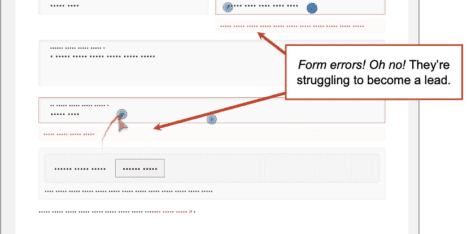I stayed in a hotel yesterday. There were some colorful abstract pictures on the wall above the bed. They really brightened up the room. But did a human paint them by hand? I hope not.
Those same pictures were probably in all the other rooms of the hotel. Hotels need a lot of art, but no one chooses a hotel room for the art. So it would be a waste of time, energy and talent to hand paint each picture.
I visited a website yesterday. There were ALT tags on the images and meta descriptions in the code. They helped optimize the site for search and make it more accessible. But did a human write them all by hand? I hope not. It’s commodity content.
Commodity content is generic, easily produced and undifferentiated from other information on the same topic. AI is great for writing this kind of content. It’s a wonderful time-saver. Humans should not do this job.
But it lacks a point of view. It makes no personal connection. It is not memorable. It has no impact.
Thought leadership has a strong point of view, based on beliefs. It often evokes emotion and creates tension. The reader can agree or disagree. AI cannot write this kind of content. Only humans can.
The difference is quantity versus quality, but there’s more to it. Should we use AI for content creation? It depends on the goal. Is the goal simply information? Or is the goal personal and persuasion?
Answer that first and it becomes clear: some content should always be written by AI. For other content, AI has only a research role, if any.
First, we’ll contrast these two types of content, then we’ll share the AI prompts for thought leadership below…
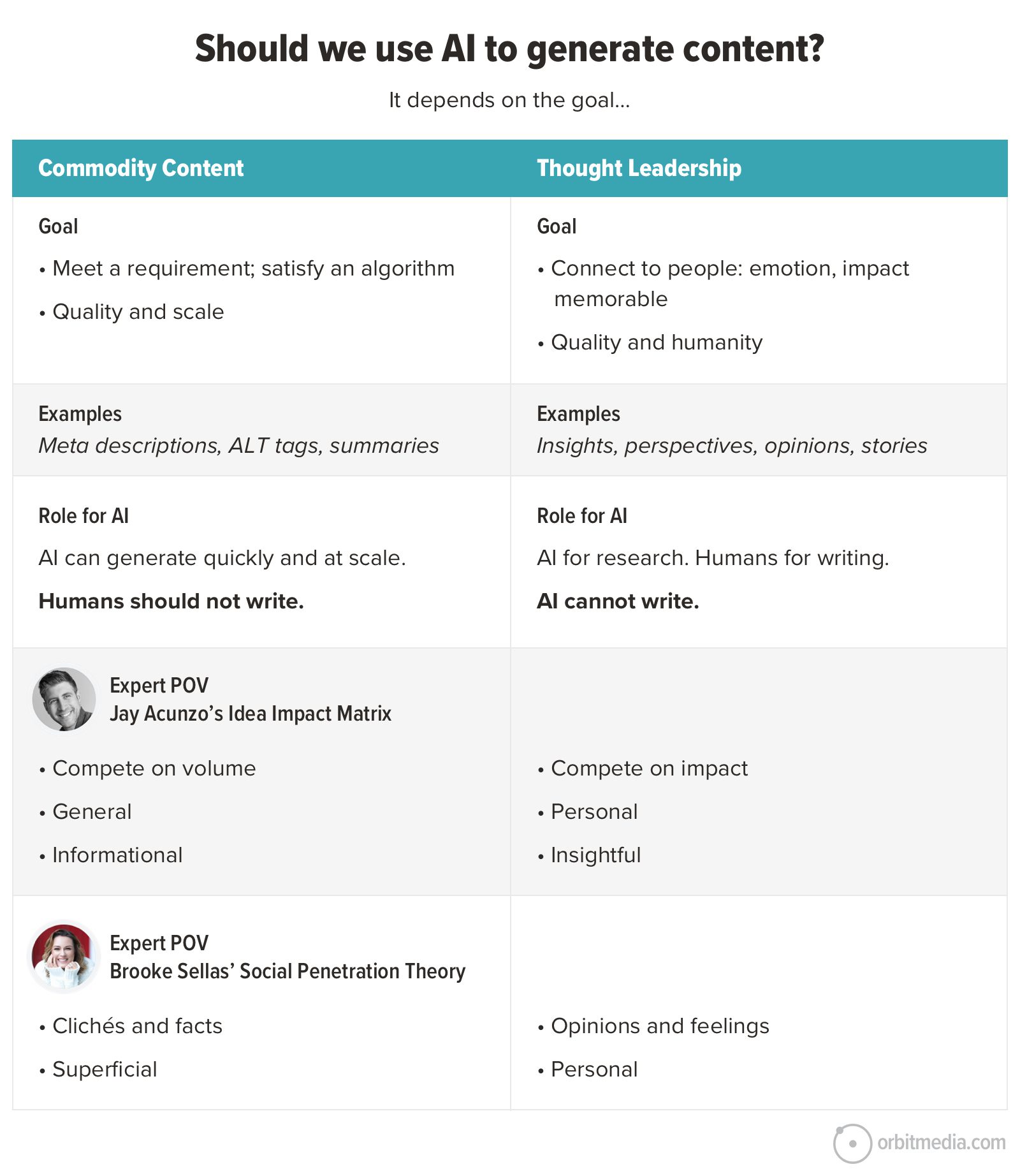
Of course, in content marketing, “writing” isn’t one thing. The content development process involves topic research, keyword research, multiple drafts, image creation, gathering contributions from influencers, on-page SEO review, editing, internal linking, content management, and of course, promotion. There are AI use cases all over the place.
But let’s look closer at the two ends of this spectrum. We’ll start with the good stuff.
Thought leadership: Impossible for AI
Not all content marketing is thought leadership. A lot of content marketing (including most of ours) is purely educational. “How-to” content may come from a point-of-view, but mostly, it isn’t based on beliefs. It isn’t making the case for anything, therefore it isn’t thought leadership.
True thought leadership comes from personal experience. It takes a stand. A thought leader takes a position for (and therefore against) something. A thought leadership piece draws a line in the sand.
I once saw Seth Godin present at a conference. It was a beautiful summer afternoon in a top-floor event space in Chicago’s Printers Row. He talked for 30 minutes, then took questions for 30 minutes. I was the first to raise my hand. I couldn’t wait to ask him about thought leadership. Here’s what he told me.
 |
Seth Godin“Thought leadership always creates tension. It’s about making assertions and you have to be willing to be wrong. You can be certain that people will disagree.“ |
I love how Seth sets the bar high. If you can’t disagree with it, it isn’t true thought leadership.
We confirmed this definition of a research piece we conducted with Mantis Research and Survey Money. We asked 480 marketers what qualifies as thought leadership. Most agreed that “strong opinions” were essential.
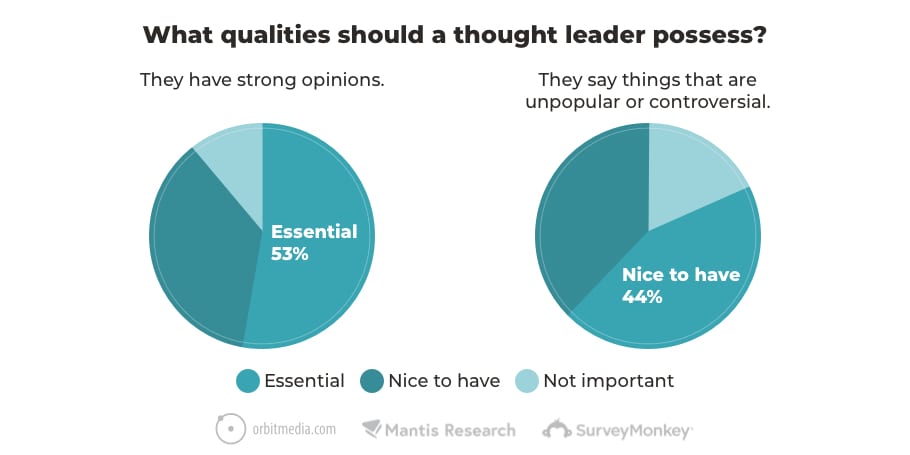
Of course, AI has no opinions. It has no life experiences. It has no beliefs or worldview. So it can’t write thought leadership content. Just in the last few paragraphs, you’ve read several examples of sentences that could never be written by an AI.
- “It was a beautiful summer day in a top-floor event space in Chicago’s Printers Row” (little stories)
- “Purely educational content is not thought leadership” (take a stand)
- “I love how Seth sets the bar high.” (share emotion)
AI can’t write that stuff. But you can.
And this is the content that has the greatest impact precisely because of its humanity. It isn’t just information, it’s emotion. It isn’t just read, it is remembered. Our friend Jay Acunzo explains the difference.
 |
Jay Acunzo, Co-founder of Creator Kitchen“AI and people both rely on LLMs as their foundations. AI has large language models. People have little life moments.“ |
Social media expert and good friend, Brooke Sellas, uses the Social Penetration Theory to explain why this kind of personal approach to content connects so well. This model describes the degrees to which content can connect, from the superficial (clichés and facts) to the core (opinions and feelings).
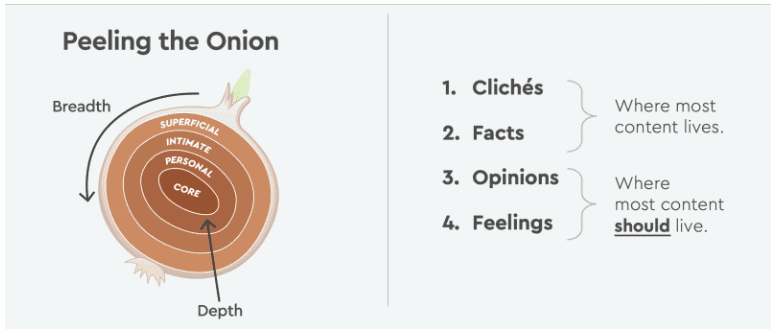
 |
Booke Sellas, Founder of B Squared Media and Author of Conversations that Connect“As humans, we haven’t changed the way we build relationships: vulnerability → trust → intimacy. Those are the basic tenets of any real connection. AI, however, lacks each one of those things, and (for now) doesn’t have the emotional depth needed to foster authentic bonds.“ |
AI is great for facts, information and commodity content. But the core is where humans connect. It’s those deeper messages that trigger loyalty and love. It’s the words that take a bit of bravery to write.
Jay Acunzo uses the Idea Impact Matrix to explain the same difference between information and emotion, commodity content and thought leadership. He puts it all content on a two-by-two matrix, with value and originality as the axes.
The top right is both insightful and personal. Here the content creator uses little personal stories connected to insights. Here, creators write small stories with big impact. And this is the content that makes an impact.

Jay suggests using personal experiences to create content that connects to insights. That content may have a common structure: “This happened… which made me realize …and that’s the thing about…” Obviously, AI doesn’t write that way because it has no experience.
Do you remember that scene in Good Will Hunting when Robin Williams and Matt Damen are sitting on the park bench? “I bet you can’t tell me what it smells like in the Sistine Chapel.” That scene still gives me chills.
How can AI help with thought leadership articles?
It’s not writing. It’s research. AI is a useful tool for discovering topics that are great for thought leadership articles. Topics that trigger emotions. Topics that others have avoided. Topics that may be missed by the big blogs.
We recommend that you always start your AI marketing methods by first training the AI on your audience first with a quick persona prompt. Then use these prompts in ChatGPT or any AI tool to quickly reveal potential thought leadership topics. Some will be silly, some will be radioactive and a few may inspire you.
5 prompts for thought leadership topics:
What are some relatively mundane, almost [industry] topics that [job title] have very strong opinions about.
What questions are people in [industry] afraid to answer?
What false things do people in [industry] believe to be true?
What are the most important topics in [industry] that are the least likely to be covered by the popular blogs?
What counter-narrative opinions about [topic] are least likely to be discussed by bloggers and thought leaders?
Find anything interesting? Anything that aligns with your content strategy? Ready to dip your toes into the thought leadership ocean? Your readers may be ready to take the dive with you. Connect the topic to a story and write something that only you can write.
It’s very easy to differentiate content from AI, because you are human. Here are three simple ways:
- Take a stand, because AI has no opinions.
- Collaborate, because AI has no friends.
- Record yourself, because AI has no face.
This would be a lovely place to end this article, but we haven’t covered the other half of the spectrum, commodity content.
If you are inspired to write, stop reading and close this tab.
If you’d like to learn when and how AI is far better at writing than humans, read on…
Commodity content: Perfect for AI
I remember when publishing a glossary with the definition of every term in an industry, was a viable SEO strategy. The goal was to attract visitors who are looking for a quick answer and then get them to click on an offer, subscribe to a newsletter or retarget them afterwards.
It was a weird idea in hindsight.
It worked for a while, but then Google launched featured snippets and knowledge panels …and click through rates dropped. SEOs and marketers discovered that visitors don’t want to click even once to get a definition or a simple fact. The decline in value of publishing informational content had begun.
Now with Google’s AI Overview, which summarizes the content of the top ranking pages and shows answers from Google’s own Knowledge Base, there will be even fewer clicks for information intent keyphrases. So an SEO strategy based on general answers to common questions has greater risk and fewer rewards than it did years ago.
Why write what an AI can generate on demand for your audience in seconds?
 |
Jay Baer, Thought leader and tequila influencer“The problem isn’t that AI can do what marketers can do. The problem is that marketers keep doing what can be done by an AI.” |
But what about that picture on the hotel room wall? There is such a thing as commodity content, some of which needs to be produced at scale. New tools are making this easier everyday.
- AI Alt Text Generator will generate ALT tags for thousands of images automatically.
- Screaming Frog v20 will generate meta descriptions for thousands of URLs automatically.
These AI powered tools are perfect for generating these little elements at scale. This is purely an efficiency play without any AI ethical considerations.
And for the content marketer, artificial intelligence can help produce drafts for things that are important, but lower-value, such as YouTube descriptions, which can be tedious to write. These little keyword-focused summaries are more for the YouTube algorithm than human readers.
YouTube description prompt:
You are an expert video marketer skilled at crafting YouTube descriptions that indicate relevance for the YouTube algorithm and giving readers a quick and clear summary of what the video is about. I’m giving you the transcript of a YouTube video. Write a detailed, keyword-focused summary with a bullet list and a call to action to get more information.
Of course, you’ll need to read the draft carefully. Fix the tone, turn the bullet list into timestamps and add links to your related content. But you saved some time, which is good. Your time is better spent writing or recording something new.
Never use AI for a human job
Here’s an example of generative AI at its worst: social media comments.
Comments are the exact opposite of commodity content. A comment is a reaction, an interaction, a response. If you use AI for this, you are a spammer.
This is what AI comment spam looks like on LinkedIn. What a nightmare.
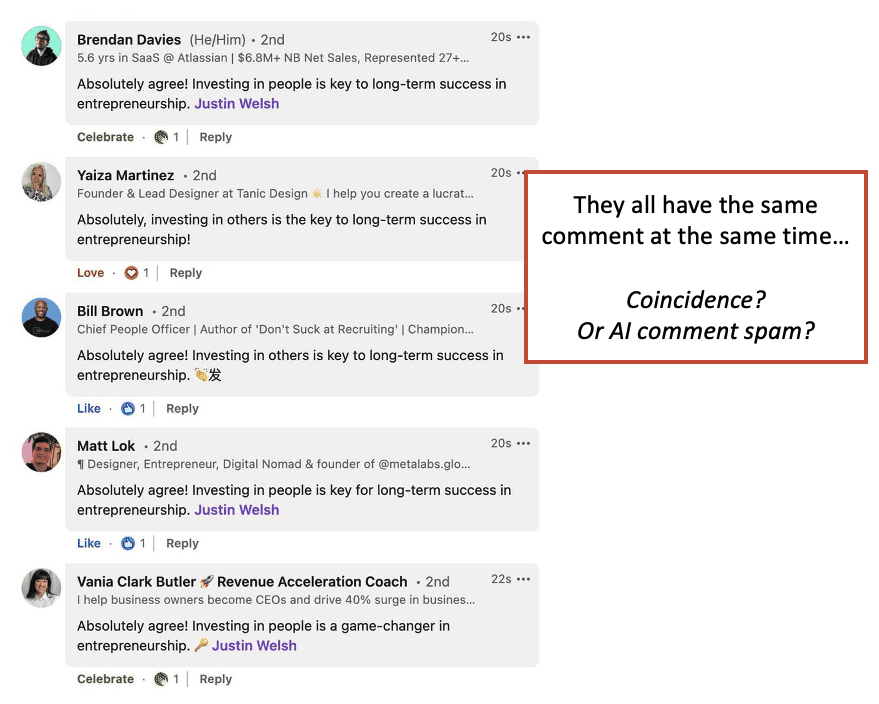
Why would someone outsource their conversations to a robot? Do they believe that generative AI can make friends for them? How can you connect on social media without socializing?
Let’s all commit to being thoughtful about when and how to use AI generated content in digital marketing. Let’s decide when it’s better and when it’s far worse. What it makes possible and what is totally impossible for an AI to do.
- Never write commodity content by hand.
- Never try use AI to write thought leadership.
- Welcome AI into the brainstorming process.
- When content needs to connect, keep it human with plenty of stories, opinions, emotion and belief.
Thought leaders need to do their research too. And AI tools are a useful tool for researching topics. But a leader doesn’t use tools to do their thinking. They think for themselves and use personal experience to give life to their writing.
Of all the steps in the content creation process, brainstorming is the best AI use case for thought leadership. Which is mostly how marketers are currently using AI technology, according to our survey of 1000 bloggers.

We’ll close with another quote from Jay Baer. This connected with me in ways that AI never will.
“You can’t be a successful content creator unless your someone’s favorite content creator.”

